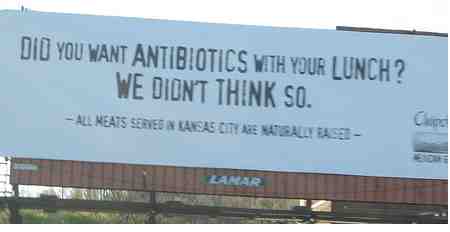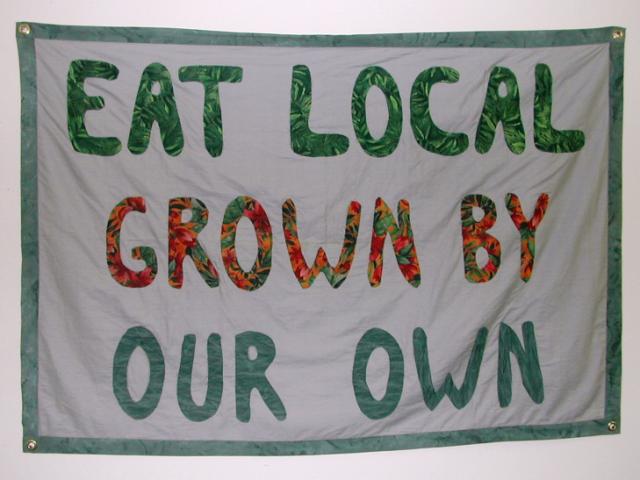Spring has sprung in Kansas. We all worked in the yard yesterday, and after a couple of cool nights later in the week, the first leafy greens will be going into the garden.
With spring comes the mantra, local is safer.
 The idea food that is grown and consumed locally is somehow safer than other food, either because it contacts fewer hands or any outbreaks would be contained, is sorta soothing, like a mild hallucinogen, and has absolutely no basis in reality.
The idea food that is grown and consumed locally is somehow safer than other food, either because it contacts fewer hands or any outbreaks would be contained, is sorta soothing, like a mild hallucinogen, and has absolutely no basis in reality.
Foodborne illness is vastly underreported — it’s known as the burden of reporting foodborne illness. Someone has to get sick enough to go to a doctor, go to a doctor that is bright enough to order the right test, live in a state that has the known foodborne illnesses as a reportable disease, and then it gets registered by the feds. For every known case of foodborne illness, there are 10 -300 other cases, depending on the severity of the bug.
Most foodborne illness is never detected. It’s almost never the last meal someone ate, or whatever other mythologies are out there. A stool sample linked with some epidemiology or food testing is required to make associations with specific foods.
Robert Brackett, senior vice president of the Grocery Manufacturers Association, and a darn fine scientist, told USA Today most foodborne illnesses don’t get noticed because not enough people get sick to alert officials that an outbreak is underway. Undetected outbreaks are more likely with "local" products delivered in small quantities and sold in a small area.
Comparing local with all that other food brings in more tenuous links and numerous erroneous assumptions. To accurately compare local and other food, a database would have to somehow be constructed so that a comparison of illnesses on a per capita meal or even ingredient basis could be made.
.jpg) But the absence of data doesn’t stop doctrine. JoLynn Montgomery, director of the Michigan Center for Public Health Preparedness at the University of Michigan told the Detroit Free Press today that one solution that is catching on is buying locally grown foods.
But the absence of data doesn’t stop doctrine. JoLynn Montgomery, director of the Michigan Center for Public Health Preparedness at the University of Michigan told the Detroit Free Press today that one solution that is catching on is buying locally grown foods.
"The less distance the food has to travel, the fewer people who touch the food, the less risk you have.”
Local can be microbiologically safe. But repeating ‘local’ while in some sorta peyote buzz doesn’t take care of the dangerous bugs. So wherever food is purchased or even grown, ask some questions:
• how are pathogenic microorganisms managed;
• is wash and irrigation water tested for dangerous bacteria;
• how is fresh produce protected from animal poop;
• what kind of soil amendments are being used and are they microbiologically safe; and,
• are you or your suppliers practicing great handwashing?
That’s a start.
.jpg) Amy, Sorenne and I wandered the grounds earlier this evening to view the overgrowth, eat a few fresh blackberries, let the dogs tear around the yard and for me to once again observe how much I suck at gardening. I’m better at taking care of the seven-month-old.
Amy, Sorenne and I wandered the grounds earlier this evening to view the overgrowth, eat a few fresh blackberries, let the dogs tear around the yard and for me to once again observe how much I suck at gardening. I’m better at taking care of the seven-month-old.
 I ride my bike around town (which is a health hazard in Manhattan), we had a fabulous salad of greens grown in our own garden last night for dinner along with the tuna steak (which wasn’t grown in Kansas), yet when I speak at a local panel or read something, it’s all these folks falling over themselves to be declared green.
I ride my bike around town (which is a health hazard in Manhattan), we had a fabulous salad of greens grown in our own garden last night for dinner along with the tuna steak (which wasn’t grown in Kansas), yet when I speak at a local panel or read something, it’s all these folks falling over themselves to be declared green. 
.jpg) Sen. Dean Florez, D-Shafter (Kern County), the majority leader in the California state Senate wrote in the
Sen. Dean Florez, D-Shafter (Kern County), the majority leader in the California state Senate wrote in the  “You know, we want to make sure our guests here and across the nation are eating nutritious items. Collect some fruits and vegetables; bring by some good healthy food. We can provide this kind of healthy food for communities across the country, and we can do it by each of us lending a hand.”
“You know, we want to make sure our guests here and across the nation are eating nutritious items. Collect some fruits and vegetables; bring by some good healthy food. We can provide this kind of healthy food for communities across the country, and we can do it by each of us lending a hand.” The idea food that is grown and consumed locally is somehow safer than other food, either because it contacts fewer hands or any outbreaks would be contained, is sorta soothing, like a mild hallucinogen, and has absolutely no basis in reality.
The idea food that is grown and consumed locally is somehow safer than other food, either because it contacts fewer hands or any outbreaks would be contained, is sorta soothing, like a mild hallucinogen, and has absolutely no basis in reality..jpg) But the absence of data doesn’t stop doctrine. JoLynn Montgomery, director of the Michigan Center for Public Health Preparedness at the University of Michigan told the
But the absence of data doesn’t stop doctrine. JoLynn Montgomery, director of the Michigan Center for Public Health Preparedness at the University of Michigan told the .jpg) The University of Southern California held its first market in February 2008, the result of meetings between students and university officials that began in fall 2007.
The University of Southern California held its first market in February 2008, the result of meetings between students and university officials that began in fall 2007. The author of the blog,
The author of the blog, 
.png) As reported by the
As reported by the  crumbling across the nation,” and it’s leading consumers to “tak[e] a healthy interest in vegetables and other locally made produce.”
crumbling across the nation,” and it’s leading consumers to “tak[e] a healthy interest in vegetables and other locally made produce.”.jpg) “It’s certainly true that food purveyors at every level should be scrupulously clean and conscientious about how they handle their food. But it’s patently untrue that farmers’ market prepared foods are unsupervised, at least here in Seattle, where both Mr. Marler and I live. Prepared food vendors are permitted and inspected by the health department. When health inspectors aren’t personally on site, the market managers act as their proxies, checking temperatures and handwashing stations. We’re also required to take classes in proper food handling procedures.”
“It’s certainly true that food purveyors at every level should be scrupulously clean and conscientious about how they handle their food. But it’s patently untrue that farmers’ market prepared foods are unsupervised, at least here in Seattle, where both Mr. Marler and I live. Prepared food vendors are permitted and inspected by the health department. When health inspectors aren’t personally on site, the market managers act as their proxies, checking temperatures and handwashing stations. We’re also required to take classes in proper food handling procedures.” Just how do some retailers define locally grown?
Just how do some retailers define locally grown? Robert Brackett, senior vice president of the Grocery Manufacturers Association, said most foodborne illnesses don’t get noticed because not enough people get sick to alert officials that an outbreak is underway. Undetected outbreaks are more likely with "local" products delivered in small quantities and sold in a small area.
Robert Brackett, senior vice president of the Grocery Manufacturers Association, said most foodborne illnesses don’t get noticed because not enough people get sick to alert officials that an outbreak is underway. Undetected outbreaks are more likely with "local" products delivered in small quantities and sold in a small area.